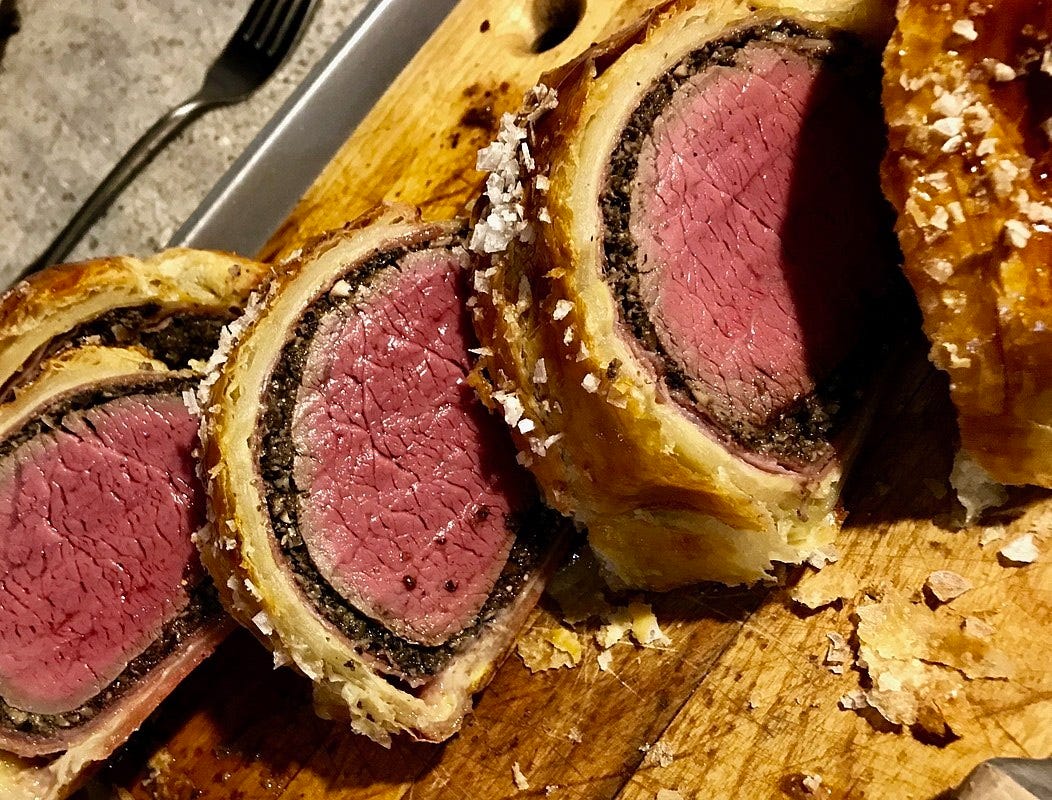Mention Beef Wellington, and it immediately signals ceremony. Its roots, however, are less precise than its polished presentation suggests. The dish first became associated with Britain in the 19th and early 20th centuries. Some food historians argue it was named in honor of Arthur Wellesley, the 1st Duke of Wellington, after his victory at Waterloo in 1815. The parallel between the duke’s strong, protective military image and the beef encased in pastry armor has long been part of the lore.
Others trace the dish’s ancestry to French and Russian kitchens. Variations of meat wrapped in pastry were already common across Europe in the 18th century. The French pâté en croûte, or Russian kulebyaka, bear a striking resemblance, suggesting Beef Wellington was less a singular invention than an adaptation that the British later claimed as their own.
Big Name Chefs
Though its origins are murky, the dish’s rise to prominence is easier to track. In the 20th century, Beef Wellington gained prestige through appearances at high-profile events and in the work of celebrated chefs. Delia Smith included it in her influential cookbooks, cementing its reputation among ambitious home cooks in Britain. In the United States, Julia Child and James Beard helped bring it into the culinary mainstream during the 1960s and 1970s, when it became a fashionable centerpiece for dinner parties.
More recently, Gordon Ramsay has been one of its more visible champions. His television series and restaurant menus made Beef Wellington synonymous with high-end modern dining. Ramsay’s interpretation, involving precise timing and a streamlined method, reintroduced the dish to younger chefs and audiences who might otherwise have dismissed it as outdated.
The Method
At its core, Beef Wellington is a lesson in balance and timing. A whole beef tenderloin is seared to develop flavor and seal in juices. A layer of finely chopped mushrooms cooked down to a paste is spread over the beef, sometimes with Foie Gras or pâté for richness. To prevent sogginess, some chefs use a thin crêpe or slices of prosciutto between the beef and pastry. Finally, the meat is wrapped in puff pastry and baked until golden.
The method requires precision: the beef must emerge medium rare while the pastry remains crisp. Achieving this balance has long been both the challenge and the allure for professionals. In restaurant settings, the preparation can be scaled, with individual Wellingtons prepared as single portions, or the classic whole roast sliced tableside for drama.
Classic Appeal
For the trade audience, Beef Wellington offers advantages. First, the high visual impact of the golden crust, cross-section layers, and dramatic carving make it a natural showpiece for special occasions. Second, the dish is adaptable. While the tenderloin remains traditional, chefs have experimented with lamb, venison, salmon, and even vegetarian versions using root vegetables or lentils. The method allows for seasonal interpretation and modern twists without losing its core identity.
Operationally, Wellingtons can be prepared ahead of service, held chilled, and baked to order. This staging makes it attractive for banquets and festive menus, reducing last-minute stress in the kitchen. Its association with celebration also gives restaurants a reliable upsell during holidays or set menus.
Going Forward
After peaking in the 1970s, Beef Wellington faded somewhat, seen as heavy or old-fashioned during the lighter dining trends of the late 20th century. Yet it has never totally disappeared. Over the past two decades, television exposure, social media, and the rise of “classics reimagined” menus have returned it to relevance. Diners value both the tradition it represents and the craft it demands from chefs.
Today, Beef Wellington sits comfortably in the space between heritage and innovation. A rare mix that explains why it still finds a place on fine dining menus worldwide.
Image Credit: https://wikipedia.org
_ _ _
© CHURRASCO PHUKET STEAKHOUSE / ALL RIGHTS RESERVED
Reprinting, reposting & sharing allowed, in exchange for a backlink and credits
Churrasco Phuket Steakhouse serves affordable Wagyu and Black Angus steaks and burgers. We are open daily from 12noon to 11pm at Jungceylon Shopping Center in Patong / Phuket.
We are family-friendly and offer free parking and Wi-Fi for guests. See our menus, reserve your table, find our location, and check all guest reviews here:
https://ChurrascoPhuket.com/
#Churrascophuket #jungceylon #phuketsteakhouse #affordablewagyu #wagyu

